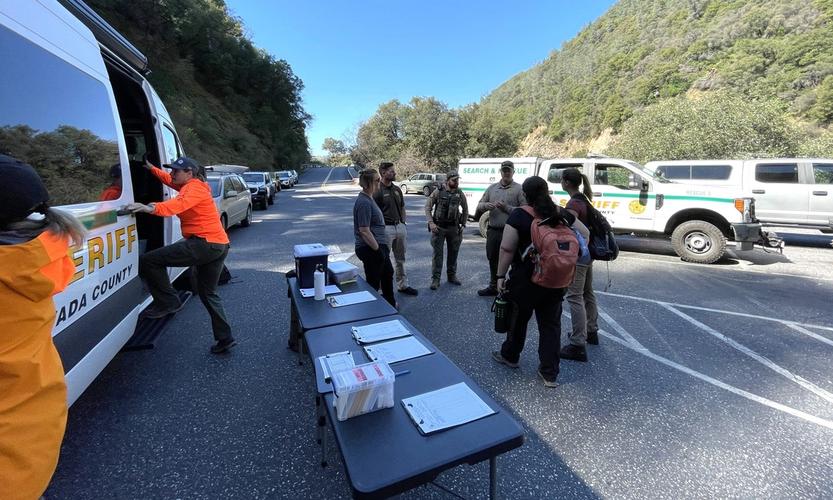No campfires outside established campfire rings in designated developed recreation sites
NEVADA CITY - Ongoing drought and warming conditions have prompted the Tahoe National Forest to initiate Stage 1 fire restrictions starting July 20, 2022. Under these restrictions, the public can still build or maintain a fire, campfire, or charcoal briquette fire in established fire rings within designated developed campgrounds and day-use sites, but not outside of those areas. Campfires will not be allowed at all Tahoe National Forest recreation sites-a list of designated developed recreation areas is linked below.
"As we move into critical fire conditions on the Tahoe National Forest, we are putting fire restrictions in place in undeveloped areas to protect our forests and surrounding communities," said Tahoe National Forest Fire Management Officer Jason Withrow. "At this point in the summer season, we are continuing to allow fires where it is safest to enjoy them-in our designated developed recreation areas."
Fire rings in developed sites are the best place to enjoy a campfire because they are designed to keep flames contained and are kept clear of debris and vegetation. These sites are also visited regularly by staff and often have a campground host nearby to monitor campfire safety. All of this mitigates the chance of an escaped campfire becoming a wildfire.
The decision to go into fire restrictions is based on a variety of factors. Fire management officials monitor the current wildfire conditions on the forest, fuel moisture levels, and predicted weather to determine when to begin, increase, and rescind fire restrictions.
Under Stage 1 restrictions, the following are prohibited:
Building or maintaining a fire, campfire, or charcoal briquette fire outside of established fire rings within designated developed campgrounds and picnic areas.
Smoking, except within an enclosed vehicle or building, a designated campground or recreation area, or while stopped in an area at least three feet in diameter that is barren or cleared of all flammable material.
Using a motor vehicle off paved, gravel or dirt National Forest System roads and trails, except within a designated developed Off-Highway Vehicle area.
Regardless of conditions and time of year, we must remain vigilant at all times to avoid human-caused wildfires. Help protect our forests, firefighters, and communities by following these principals when out on forested lands:
Campfires: Attend your campfire at all times. Ensure your fire is completely extinguished: drown with water (NOT dirt), stir with your shovel, drown again, and feel for any heat using the back of your hand. Continue this process until no heat remains.
Stoves: If using pressurized or bottled liquid fuel stoves, lanterns, or heating devices, use in barren areas with at least 3 feet of clearance from grasses and other debris that may catch fire. Prevent stoves from tipping.
Vehicles: When traveling, ensure your chains are properly connected. The hot underside of the vehicle and dragging chains can start a fire. Stick to driving on designated roads and trails and be careful to not park your car or OHV in tall, dry, vegetation, including grass. The Tahoe National Forest Motor Vehicle Use Map can be found at https://www.fs.usda.gov/detail/tahoe/maps-pubs/?cid=fseprd638275.
Spark Arrestors: Ensure that all internal or external combustion engines have a spark arresting device properly installed, maintained and in effective working order.
Flammable Items: Fireworks are prohibited on all national forests year-round, leave them and all other pyrotechnic devices at home. Always use caution with smoking. Extinguish all smoking materials dead out on bare soil. Pack out all cigarette butts and filters.
The full Forest Order and list of designated developed recreation sites can be found at https://www.fs.usda.gov/Internet/FSE_DOCUMENTS/fseprd1044918.pdf.TNF Press Release - July 19, 2022
Featured Articles

Human Remains Found Near South Yuba Bridge in March Identified →
December 17, 2025
Authorities identify remains found in March as Aaran Sloan Taylor, seeking next of kin.
Transfer Station Burn Suspended After Community Concerns →
December 16, 2025
Sierra Hardware Plans Extensive Repairs After Flood Damage →
December 8, 2025
Sheriff’s Office Accepts $60,000 Grant for New Search and Rescue Team →
December 2, 2025
Confusion Surrounds Release of the Plumas County Grand Jury’s Report →
December 4, 2025